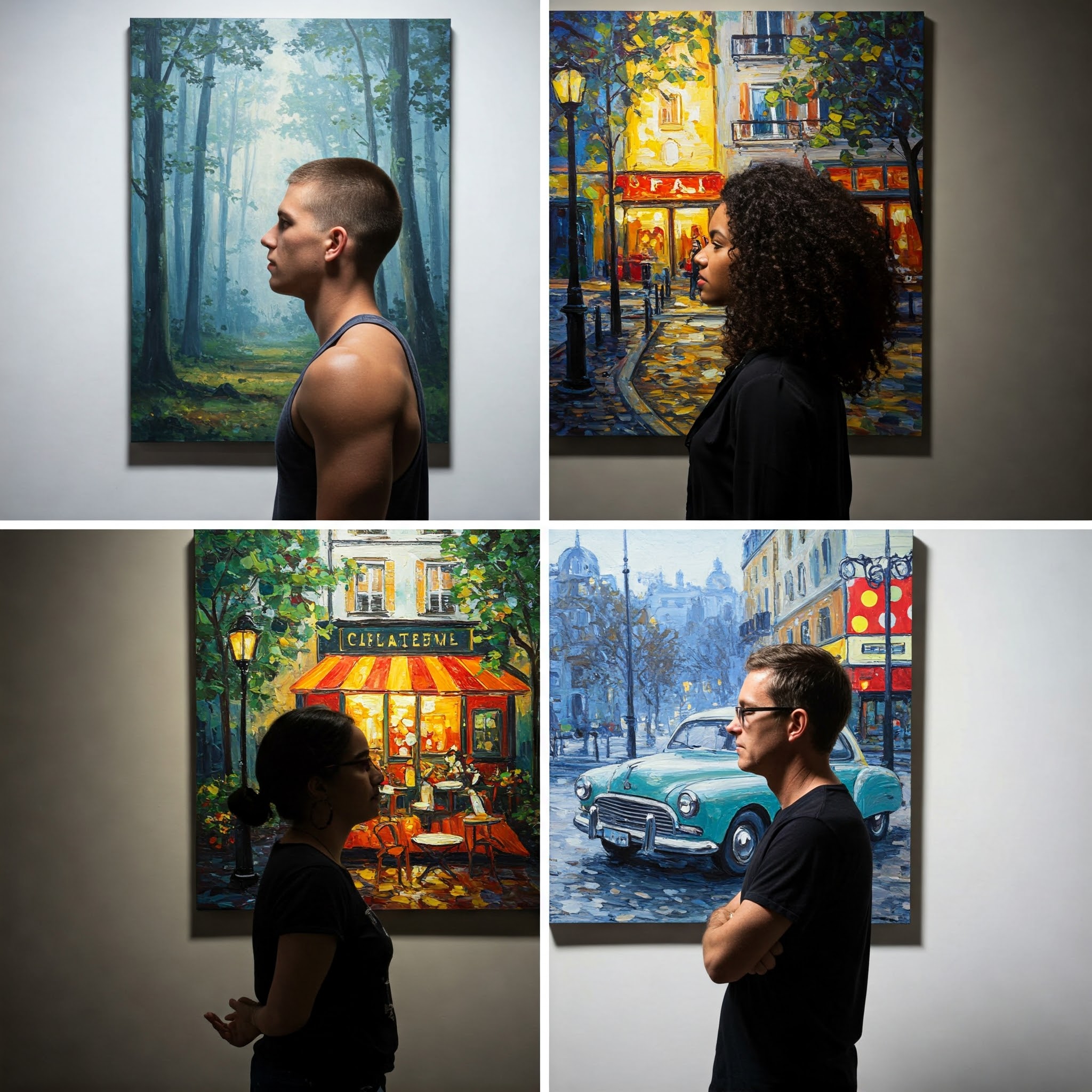Have you ever wondered why your friend adores abstract expressionism while you’re drawn to Renaissance masterpieces? Or why your partner is captivated by surrealist paintings that leave you feeling confused? The diversity of artistic preferences is as vast as art itself, reflecting our unique personalities, experiences, and cognitive processes. Understanding why different people like different art styles isn’t just fascinating—it offers profound insights into human psychology, cultural influences, and the deeply personal nature of aesthetic appreciation.
Key Points
- Personal art preferences are shaped by psychological factors including personality traits and cognitive processing styles
- Cultural background and upbringing significantly influence artistic taste development
- Educational experiences and exposure to art history affect style preferences
- Emotional responses to art vary based on individual experiences and memories
- Generational differences create distinct patterns in art style preferences
- Neurological factors play a role in how we perceive and appreciate different art forms
The Psychological Foundation of Art Preferences

Our brains are as unique as our fingerprints, and this individuality extends to how we process and respond to visual stimuli. Research in aesthetic psychology has revealed fascinating connections between personality traits and art preferences that help explain why we’re drawn to certain styles over others.
Personality Traits and Art Style Connections
Studies have consistently shown correlations between specific personality dimensions and artistic preferences. People who score high on openness to experience—a trait associated with intellectual curiosity and imagination-often appreciate abstract, complex, and unconventional art forms. They’re more likely to enjoy the challenging visual language of cubism or abstract expressionism.
Conversely, individuals who value tradition and predictability may find more comfort and pleasure in representational art with clear subjects and narratives, such as traditional landscapes or portraiture. A 2018 study published in Psychology of Aesthetics, Creativity, and the Arts found that participants with higher levels of neuroticism tended to prefer darker, more emotionally intense artworks, while extroverts often gravitated toward vibrant, energetic pieces with bold color palettes.
Cognitive Processing Styles
The way we mentally process information significantly influences our art preferences. Some people are “verbalizers” who process information primarily through language, while others are “visualizers” who think predominantly in images.
Visualizers often appreciate detailed, realistic art that provides rich visual information to process, such as the works found in the Realism movement. Meanwhile, verbalizers may be more drawn to conceptual or narrative-driven art that tells a story or conveys ideas that can be verbalized.
Additionally, individuals differ in their need for cognitive closure—the desire for definite answers and discomfort with ambiguity. Those with a high need for closure typically prefer more straightforward, representative art styles, while those comfortable with ambiguity may enjoy the open-ended interpretations offered by abstract or surrealist works.
Cultural Influences on Artistic Taste

“Art is not created in a vacuum. It’s a reflection of the culture that produces it, and our response to it is equally shaped by our cultural context.”
John Berger
Our cultural background serves as a lens through which we view and interpret art, often without conscious awareness of its influence.
Cultural Context and Art Appreciation
Growing up in different cultural environments exposes us to distinct artistic traditions, symbols, and aesthetic values. Someone raised in Japan might naturally appreciate the minimalist aesthetics and asymmetrical balance of traditional Japanese paintings, while someone from Western cultures might initially find greater connection to the Renaissance tradition of perspective and realism.
Research has demonstrated that people from collectivist cultures (like many East Asian societies) tend to process visual information more holistically, taking in the entire scene and relationships between elements. In contrast, those from individualistic cultures (like many Western societies) often employ a more analytical approach, focusing on central objects and categorization. These different perceptual styles can lead to preferences for art that aligns with familiar processing methods.
Socioeconomic Factors
Access to art education and exposure varies dramatically across socioeconomic backgrounds, creating different pathways to art appreciation. Those with greater access to museums, galleries, and formal art education may develop more diverse preferences and greater comfort with “high art” styles that require contextual knowledge to fully appreciate.
A 2020 study from the Cultural Sociology journal found that early exposure to diverse art forms was the strongest predictor of developing varied artistic tastes in adulthood, regardless of current socioeconomic status.
Education and Art History Knowledge
Our educational experiences fundamentally shape how we engage with art, often determining whether we approach a painting with confidence or confusion.
The Impact of Art Education
Formal art education provides tools for analyzing and appreciating diverse art styles. Understanding the historical context of Impressionism or the revolutionary intent behind Abstract Expressionism can transform a seemingly chaotic canvas into a meaningful experience.
People with art history knowledge might appreciate works based on their historical significance, technical innovation, or influence on subsequent movements. They might value a Picasso not just for its visual appeal but for its groundbreaking approach to representation and perspective.
The Development of Visual Literacy
Visual literacy—the ability to interpret, negotiate, and make meaning from visual information—develops through education and exposure. Those with higher visual literacy can “read” more complex visual languages, including highly abstract or conceptual works that might seem inaccessible to others.
This explains why some art styles that initially provoke rejection (like Cubism or Abstract Expressionism) become more appealing as viewers develop the visual vocabulary to understand them.
Personal Experiences and Emotional Connections

Art preferences are deeply personal, often tied to our individual life stories and emotional landscapes.
Nostalgic Associations
The art styles we encounter during formative years often retain special significance throughout our lives. For many, the art that surrounded them in childhood—whether fine art, illustrations, or visual media—creates powerful nostalgic connections that influence later preferences.
For example, someone who grew up with Art Deco architecture might feel a lifelong affinity for the geometric patterns and stylized forms characteristic of 1920s and 1930s visual culture.
Emotional Responses to Visual Elements
| Visual Element | Common Emotional Response | Example Art Style |
|---|---|---|
| Bold, warm colors | Excitement, energy, passion | Fauvism, Expressionism |
| Cool, muted tones | Calmness, melancholy, reflection | Tonalism, some Impressionism |
| Sharp angles | Tension, dynamism, conflict | Futurism, Constructivism |
| Smooth curves | Harmony, comfort, sensuality | Art Nouveau, Rococo |
| High contrast | Drama, intensity, clarity | Baroque, Chiaroscuro |
| Low contrast | Subtlety, ambiguity, dreaminess | Sfumato, some Tonalism |
Different art styles leverage these visual elements to evoke specific emotional states. Our individual emotional profiles and experiences determine which of these states we find most resonant or rewarding.
Generational Differences in Art Preferences
Each generation grows up in a unique visual landscape that shapes their aesthetic sensibilities and artistic references.

Historical Context and Generational Aesthetics
Baby Boomers (born 1946-1964) came of age during periods of significant social change, often showing appreciation for both traditional representational art and the revolutionary styles that emerged during their formative years, such as Pop Art and Minimalism.
Generation X (born 1965-1980) grew up during the rise of postmodernism and often demonstrates comfort with irony, reference, and stylistic mixing in art. Their preferences frequently include neo-expressionism and the emergence of street art as a legitimate form.
Millennials (born 1981-1996) and Generation Z (born 1997-2012) have been shaped by digital technologies and globalization, often showing interest in digital art forms, immersive experiences, and art that addresses social justice themes. Their preferences frequently cross traditional boundaries between fine art, design, and popular visual culture.
Media Influence on Taste Formation
The dominant media of each generation significantly influences their visual preferences. Those who grew up with black and white photography and film may process visual information differently than generations raised on color television, video games, or smartphone screens.
Recent studies on digital natives suggest that constant exposure to rapid visual stimuli may be creating generations with greater comfort with non-linear narrative, fragmentation, and visual complexity in art.
Neurological Factors in Art Appreciation
Recent advances in neuroaesthetics—the study of the neural processes underlying aesthetic experience—have revealed fascinating insights into why we respond differently to art styles.
Brain Structure and Function
Functional MRI studies have shown that different types of art activate distinct neural pathways. Representative art typically engages object recognition systems in the visual cortex, while abstract art may activate regions involved in emotional processing and problem-solving.
Interestingly, research has found that expert art viewers show different patterns of neural activation than novices when viewing the same artwork, suggesting that experience and knowledge physically reshape how our brains process art.
Genetic Predispositions
Some aspects of visual processing may have genetic components that influence art preferences from birth. Variations in color perception, pattern recognition, and visual-spatial processing can all impact which art styles an individual finds most stimulating or pleasurable.
A 2019 twin study published in the Journal of Vision found that identical twins showed significantly more similar preferences for specific visual patterns and compositional structures than fraternal twins, suggesting a genetic component to some aesthetic preferences.
Embracing Diversity in Artistic Tastes

The rich variety of human responses to art isn’t just interesting—it’s essential to the vitality of artistic culture and personal growth.
The Value of Different Perspectives
The diversity of art preferences ensures that countless artistic traditions can flourish simultaneously, creating a richer cultural landscape than any single aesthetic could provide. When we understand that art preferences reflect our unique makeup rather than objective quality judgments, we can approach unfamiliar styles with greater openness.
Expanding Your Artistic Horizons
While our preferences have deep roots, they aren’t fixed. Challenging yourself to engage with art styles outside your comfort zone—whether Surrealism, Impressionism, or Contemporary abstract art—can expand your aesthetic range and provide new forms of visual pleasure.
Try these approaches to explore unfamiliar art styles:
- Learn about the historical context and intent behind the style
- Focus on formal elements like color, composition, and texture
- Consider the emotional response the work evokes, separate from judgment
- Visit diverse exhibitions and galleries to experience different styles firsthand
- Join discussions with enthusiasts of styles you don’t typically enjoy
Conclusion
The question of why different people like different art styles reveals the beautiful complexity of human perception, cognition, and culture. Our artistic preferences are as unique as we are—shaped by our psychological makeup, cultural background, educational experiences, personal histories, and even our neurological wiring.
Rather than viewing artistic taste as a hierarchy with some preferences superior to others, we can appreciate how diverse responses to art reflect the rich tapestry of human experience. In understanding the factors that shape our own preferences and those of others, we gain not just insight into art, but into the fascinating diversity of human consciousness itself.
Whether you’re drawn to the meticulous detail of Realism, the emotional intensity of Expressionism, or the conceptual challenges of contemporary abstract art, your preferences tell a story about who you are and how you see the world—a story worth exploring and expanding throughout your life.



